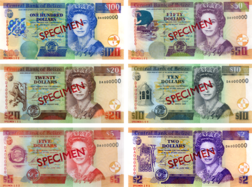Belize dollar
| Belize dollar | |
|---|---|
| Belize dollar (English) | |

Obverse of the 2003 banknote series
|
|
| ISO 4217 | |
| Code | BZD |
| Number | 084 |
| Exponent | 2 |
| Denominations | |
| Subunit | |
| 1⁄100 | cent |
| Symbol | $ |
| Banknotes | $2, $5, $10, $20, $50, $100 |
| Coins | 1, 5, 10, 25, 50 cents, $1 |
| Demographics | |
| User(s) |
|
| Issuance | |
| Central bank | Central Bank of Belize |
| Website | www |
| Valuation | |
| Inflation | 2.8% |
| Source | The World Factbook, 2007 est. |
| Pegged with | United States dollar |
| Value | 2 BZD = 1 USD |
The Belize dollar is the official currency in Belize (currency code BZD). It is normally abbreviated with the dollar sign $, or alternatively BZ$ to distinguish it from other dollar-denominated currencies.
It is divided into 100 cents. The official value is pegged at 2 BZ$ = 1 US$.
The first dollars to circulate in British Honduras were Spanish dollars, some of which were counterstamped with the monogram of a crowned –G-R– (Latin: Georgius Rex, King George.) They circulated between 1765 and 1825 at a value of 6 shillings AND 8 pence. i.e. one third of a pound sterling.
In 1825, an imperial order-in-council was passed for the purpose of introducing the British sterling coinage into all the British colonies. This order-in-council made sterling coinage legal tender; it set the exchange rate between sterling and the Spanish dollar at $1 = 4s 4d. This exchange rate was supposed to be based on the value of the silver in the Spanish dollars as compared to the value of the gold in the British sovereigns. The realistic exchange rate would have been $4.80 = £1 (equivalent to $1 = 4s 2d), and so the unrealistic exchange rate that was contained in the 1825 order-in-council led to the initiative being largely a failure. Remedial legislation came about in 1838 with a new order-in-council, which did not apply to the British North American colonies due to minor rebellions in Upper and Lower Canada. The 1838 legislation introduced the correct rating of $1 = 4s 2d.
When the original order-in-council of 1825 was introduced in Jamaica, Bermuda, and British Honduras, the local authorities set aside the mistaken rating of $1 = 4s 4d, and they unofficially used the alternative rating of $1 = 4s. The Bahamas would later adopt this same approach. When the 1838 remedial legislation came into force, sterling was well established in these territories, the Spanish dollar had been barred from circulation, and the authorities had no desire to adopt the devaluation that would have been associated with the correct rating of $1 = 4s 2d. The British shilling, referred to locally as a 'Maccaroni', was equal to one quarter of a dollar, and the system was working very satisfactorily.
...
Wikipedia
